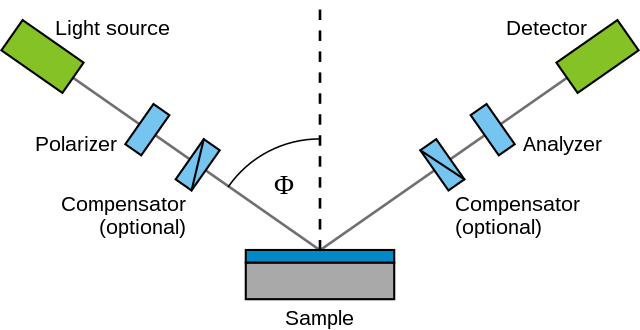Ellipsometry for Nanotechnology: Measuring Thin Films
Definition:Ellipsometry is a sophisticated optical technique used for the investigation of the dielectric properties of thin films. It measures the change in polarization as light reflects or transmits from a material structure. This article delves into the definition, principles of operation, and key features of ellipsometry, providing insights into its applications and limitations.

Definition and Principles of Operation
Ellipsometry is a non-destructive, optical measurement technique that characterizes the optical properties of thin films. It is highly sensitive to changes in the thickness and refractive index of the film.
The principle of operation of ellipsometry involves measuring the change in polarization of light upon reflection or transmission. The technique does not measure the intensity of the light directly but rather the phase shift that occurs between the s- and p-polarized components of the incident light beam.
Basic Components
The basic components of an ellipsometer include a light source, polarizer, sample stage, analyzer, and detector. The light source emits a beam of light, which is polarized by the polarizer. After interacting with the sample, the light's polarization state is analyzed by the analyzer before it reaches the detector.
This setup allows for the precise measurement of the ellipsometric angles, Psi (Ψ) and Delta (Δ), which are directly related to the optical properties of the material being studied.
Measurement Process
The measurement process of ellipsometry is characterized by its sensitivity to the thin film's thickness and optical constants. By measuring the change in polarization, ellipsometry can deduce the complex refractive index or dielectric function of the film.
These measurements are typically represented in terms of the ellipsometric angles, Ψ and Δ, which provide comprehensive information about the film's optical properties.
Key Features of Ellipsometry
Ellipsometry offers several unique features that make it an indispensable tool in the field of thin film analysis.
- Non-destructive Analysis: Ellipsometry does not alter or damage the sample, making it ideal for sensitive materials.
- High SensitivityB: It can detect sub-nanometer changes in film thickness and minute variations in optical properties.
- Wide Material Applicability: Ellipsometry can be applied to a broad range of materials, including dielectrics, semiconductors, and metals.
- Complex Refractive Index Measurement: It provides detailed information about the complex refractive index or dielectric function of the material.
Advantages over Other Techniques
Compared to other thin film measurement techniques, ellipsometry offers superior sensitivity and non-destructive analysis. Its ability to measure the complex refractive index and thickness of thin films with high precision sets it apart from techniques like reflectometry or spectroscopy.
Limitations
Despite its advantages, ellipsometry has some limitations. The technique requires complex data analysis and interpretation, and the accuracy of the results is highly dependent on the quality of the model used to describe the optical properties of the film.
Applications of Ellipsometry
Ellipsometry finds applications in various fields, including materials science, semiconductor manufacturing, and surface chemistry.
- Materials Science
In materials science, ellipsometry is used to study the optical properties and thickness of thin films, aiding in the development of new materials with desired optical characteristics.
- Semiconductor Manufacturing: Ellipsometry is crucial in semiconductor manufacturing, where it is used for the precise control of thin film deposition processes, such as Atomic Layer Deposition (ALD) and Chemical Vapor Deposition (CVD).
- Surface Chemistry: Ellipsometry is also applied in surface chemistry to investigate surface modifications, adsorption processes, and the characterization of thin organic layers.
- Ellipsometry in Nanotechnology: One of the burgeoning fields where ellipsometry plays a significant role is nanotechnology. With the increasing focus on nanomaterials and nanostructures, ellipsometry provides valuable insights into the optical properties and structural characteristics of these tiny components. By utilizing ellipsometry in nanotechnology research, scientists can precisely analyze the behavior of thin films at the nanoscale, contributing to advancements in areas such as nanoelectronics, nanophotonics, and nanomedicine.
- Nanoelectronics: In the field of nanoelectronics, ellipsometry aids in the characterization of ultra-thin films used in nanoscale electronic devices. Understanding the optical properties of these materials is crucial for optimizing device performance and reliability.
- Nanophotonics: Ellipsometry is instrumental in the field of nanophotonics, where light-matter interactions at the nanoscale are explored. By accurately measuring the optical constants of nanostructured materials, researchers can design and engineer novel photonic devices with enhanced functionalities.
- Biology: Ellipsometry enables sensitive detection and quantification of biomolecules (e.g., proteins, DNA) for diagnostics, the real-time study of biomolecular interactions for drug development and biological research, and the precise analysis of biofilm thickness and composition, aiding in areas like medical device development and environmental monitoring.
Conclusion
Ellipsometry is a powerful and versatile technique for the analysis of thin films. Its non-destructive nature, combined with high sensitivity and applicability to a wide range of materials, makes it an essential tool in both research and industrial settings. Despite its complexity, the detailed information it provides about the optical properties of materials is unparalleled, driving advancements in various scientific fields.
Further Reading
Light, Science & Applications, "Machine learning powered ellipsometry"
